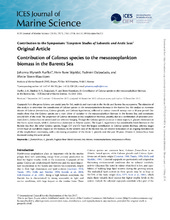Contribution of Calanus to the mesozooplankton biomass in the Barents Sea
Peer reviewed, Journal article
Published version

Åpne
Permanent lenke
http://hdl.handle.net/1956/19658Utgivelsesdato
2018Metadata
Vis full innførselSamlinger
Originalversjon
https://doi.org/10.1093/icesjms/fsx221Sammendrag
Copepods from the genus Calanus are crucial prey for fish, seabirds and mammals in the Nordic and Barents Sea ecosystems. The objective of this study is to determine the contribution of Calanus species to the mesozooplankton biomass in the Barents Sea. We analyse an extensive dataset of Calanus finmarchicus, Calanus glacialis, and Calanus hyperboreus, collected at various research surveys over a 30-year period. Our results show that the Calanus species are a main driver of variation in the mesozooplankton biomass in the Barents Sea, and constitutes around 80% of the total. The proportion of Calanus decreases at low zooplankton biomass, possibly due to a combination of advective processes (low C. finmarchicus in winter) and size selective foraging. Though the Calanus species co-occur in most regions, C. glacialis dominates in the Arctic water masses, while C. finmarchicus dominates in Atlantic waters. The larger C. hyperboreus has considerably lower biomass in the Barents Sea than the other Calanus species. Stages CIV and CV have the largest contribution to Calanus species biomass, whereas stages CI-CIII have an overall low impact on the biomass. In the western area of the Barents Sea, we observe indications of an ongoing borealization of the zooplankton community, with a decreasing proportion of the Arctic C. glacialis over the past 20 years. Atlantic C. finmarchicus have increased during the same period.
